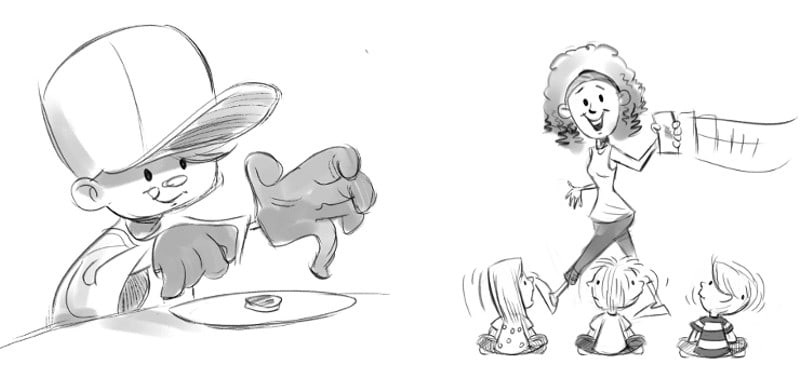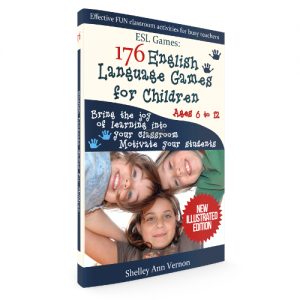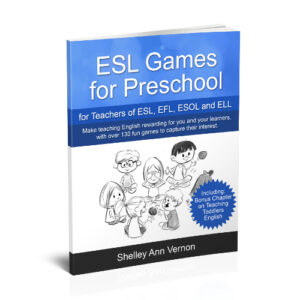Practical large group preschool activities can be hard to find. Teaching English with a large kindergarten class can be a farce. Firstly, large groups of children can be unwieldy to organise. In addition, children often become over-excited and stop learning. Furthermore, it’s impossible to give children the individual attention they need, and pupils do not learn as much as in small group lessons.
Unfortunately, there are countries where kindergarten classes have far too many children. Here is a question from a teacher who needs large group preschool activities:
What are the best games for a large class?
“I am using your materials and games, and they are helping. However, I am teaching in China, and my classes have more than 20 students in them. What are the best games for that large of a class? How could I modify some of the games so there is less waiting time and it can be more productive for my students?”
Answer
Fun Preschool ESL Games for Children contains activities with variants and tips for large groups. For example, in games where pupils take turns, have five children take a turn together. That way, with 20 kids, you only have four turns. Consequently, you need five sets of flashcards or whatever materials the activity requires.
Group participation
In other large group preschool activities, one or two children may be in the center, performing an action or doing something specifically for the game. However, while this is happening, the others also participate, but in a lesser way. Joining in may mean chanting something at the start of each round or clapping a rhythm. The entire class might jump up on a specific word or trigger point. Some pupils may have to switch places. These tricks engage the whole group even though only a few kids are in the spotlight.
Here is a great large group preschool activity adapted for twenty kids.
Gigantic Gloves Game
Category: Step 1 listening or Step 3 speaking
Group size: 2 to 20
Space needed: Flexible, can be played on tables
Pace: Wake up
Materials: You’ll need some large gloves, a hat, sunglasses, picture flashcards, and a large die. However, you may replace any item with a suitable alternative as long as it is quick and straightforward to put on.
How to play
To prepare, display a short line of flashcards of the vocabulary (not necessarily clothing). Then, place the clothes nearby. With 20 children, have five lines of flashcards and five sets of clothing, which do not need to be identical. Next, have children sit in five lines. It’s helpful to use curved lines so all children can watch the action.
To play, the first child in each line gets up, puts on the hat, sunglasses, and gloves, and tries to pick up one of the flashcards with the giant gloves on. If they manage to pick it up, they name it and take it back to their line. Then, the next child in line puts on the hat, sunglasses, and gloves and goes to pick up the next flashcard.
Once you have played this a couple of times, here is a variation to add excitement and involve the entire group. Children sit in a circle, and everyone has a die. On ‘Go!’ two or more pupils get up, dress up, and try to pick up the flashcard or object. In the meantime, all the other children furiously roll their dice until they get a six. When a child gets a six, that die is placed in the centre of the circle. Keep going till four people have rolled a six, and at that point, the game stops. Tweak the number of sixes to be produced so that most pupils manage to pick up the flashcard before the activity ends. However, it’s a good idea to help a child get the flashcard once there is only one more six to go. Preschoolers are pretty likely to dissolve into tears if they don’t succeed. Avoid this sense of failure by helping them or allowing them extra time. Either way, never have losers!
Tips
Experiment before the game so you do not end up playing with something that children cannot pick up with the gloves on. For a start, make sure that you can do it with gloves! Then, during the lesson, help any children who can’t do it by making it more manageable. For example, placing flashcards on books makes them easier to pick up because you can slide them over the edge. If flashcards prove too elusive, use 3D items, but again, test them first yourself! Any kids who fail will feel disappointed and probably cry, and you don’t want anyone feeling sad and disappointed in your English class!
Resources for large group preschool activities
Throughout Fun Preschool ESL Games for Children, you will find large group preschool activities, either as variants to a game or as tips on dealing with big classes. That said, the preschool games book is ideal for groups of 2 to 20 kids, while the primary school games book is great for even bigger classes.
So check out the complete game descriptions and variants. Look for the group size in the game description box, and if it says “Any,” then the activity is good for large groups or has a large class variant.
Classroom management issues
To keep control of the class and excitement levels down, use vocabulary listening games. Have pupils participate in total silence, including not having your chair make any noise as you get up or tip-toeing across the room. The whole game is about being as quiet as possible, and if anyone makes a noise, that person has to do a monkey dance or something silly, but not humiliating. On the other hand, you may find kids start deliberately making noise so that they can do the monkey dance! In that case, switch the dance to naming a flashcard, so everyone can revise vocabulary instead of monkeying around!
You will inevitably have some kids who aren’t interested. If that is just two or three kids, while MOST are participating, that’s good enough! As long as the others are not disruptive, okay if some are off in their own world. Don’t worry; they will still be hearing English around them. Some pupils may be having a pause in their concentration. Don’t aim to have everyone 100% of the time since it’s totally unrealistic. Remember when you were in lectures, you didn’t listen and concentrate on absolutely everything all of the time.
For further classroom management tips please check out the following posts:
Classroom-management-attention-grabbers
Two-tips-managing-large-classes-preschool-children
Ask me any questions you may have in the comments box, and I’d love to hear from you!
All the best, Shelley Ann Vernon
-
Sale Product on sale
 ESL Games book for primary & middle school children
ESL Games book for primary & middle school children€19.97Original price was: €19.97.€15.33Current price is: €15.33.Rated 5.00 out of 5 based on 1 customer rating -
Sale Product on sale
 Preschool games book
Preschool games book€19.97Original price was: €19.97.€11.97Current price is: €11.97.


